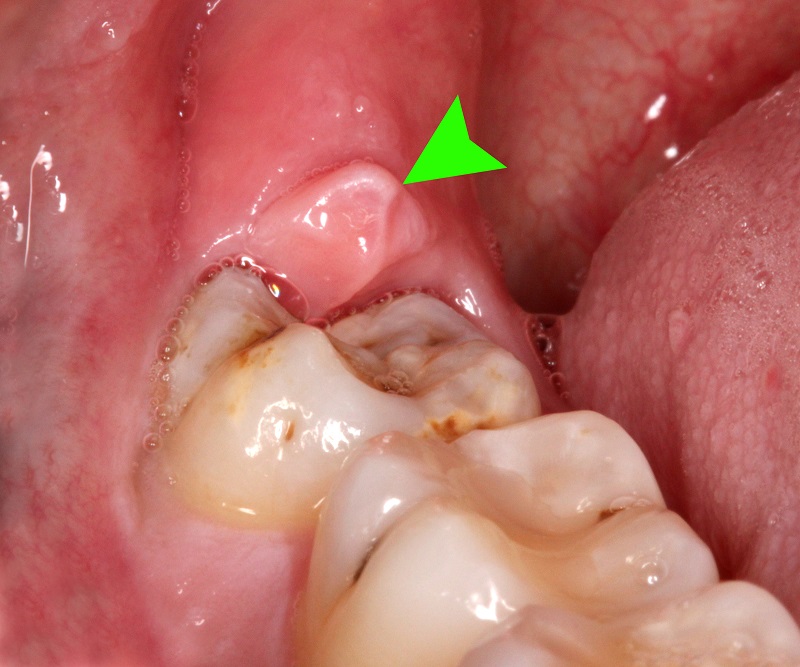Irritations and pain in the mouth often come from infections. In this article, we discuss one such condition, called pericoronitis. This painful dental disease, whose effects can spread to other parts of the body as well, has the hallmarks of swelling and inflammation. Read below to learn more about the creation and causes of this disease, its effects, and how a dentist or you can treat it. You will find remedies that range from surgery to simple remedies with ingredients resting in your home’s cabinets.
What Is Pericoronitis?
As explained more fully below, pericoronitis is a disease that results from an infection of an opening created during the development of the wisdom teeth. As such, the disease makes its appearance mostly in patients in their late teens or early twenties.
In this disease, the soft tissues around a tooth crown typically swell into an accumulation of pus, otherwise known as an abscess. This swelling is often the result of an infection that attacks the oral cavity.
Pericoronitis Causes
The opening for the bacteria to invade the gums results when wisdom teeth partially break through the gum. In other words, the teeth only partially erupt or go through the gums. When this happens, a flap of gum tissue next to the wisdom tooth is created. Here lies the portal for infection.
Food and plaque, which represent a film of bacteria, constitute the major sources of infection in the gum openings around the wisdom teeth. The flap becomes a secure collection bin for the bacteria. Herein is the essence of pericoronitis causes.
Plaque forms in gums and around teeth when carbohydrate-laden foods interact with bacteria. These foods include milk, sodas, and desserts. The reaction of bacteria with carbohydrates yields acids that can result in inflammations and compromise the bone structure that supports the teeth.
Often, plaque testifies to poor dental hygiene. The condition also results from stress or even upper respiratory tract infections.
Pericoronitis Symptoms
Look to or feel what is happening in your gums for signs of pericoronitis. These signs include:
- Swollen gum tissues. This phenomenon evidences the filling of fluid in the infected gums.
- Pain or tenderness around the gums

The symptoms extend beyond the gums in the affected molars. Patients with this oral disease may also present with:
- Swelling in the lymph nodes
- Pain in the rest of the mouth or the neck
- Swelling in the face
- A slight fever or an increase in body temperature
- General malaise — characterized by general discomfort or illness
- Difficulty in opening the mouth.
- Spasms of the jaw muscles.
- A bad taste in your mouth. This is the leaking pus that also signals an onset of a periodontal episode.
Pericoronitis Treatment
The extent of the symptoms or reach of the disease often shapes the pericoronitis treatment. When localized to the gums or teeth around the infected areas, a dentist may irrigate to remove the fluid or pus. Analgesics such as ibuprofen and acetaminophen can reduce the pain and other symptoms, especially when the pain is local.
Since the disease develops from bacteria, antibiotics will also form part of the treatment regimen. Your dentist will, most likely, prescribe oral antibiotics such as penicillin to deal with the spread of the infection, as opposed to acute or chronic inflammation from the disease. Antibiotics typically do not address the symptoms, but get to the cause.
Even with the chronic (or short-term, acute) inflammation, antibiotics may be the primary resort when irrigation or removal of the pus is not possible.
In severe cases, patients may undergo oral surgery. These procedures may include:
- Low-level laser procedures to remove the inflamed area
- Removal of the flap or infected tooth
- Extraction of the tooth opposite the affected one
Resorting to things in your home can also afford relief from the pain and inflammation:
- Dissolve a tablespoon of salt in boiled water, then swish for about half a minute. The salt water rinse serves as an anti-bacterial disinfectant, anti-inflammatory agent, and tool for removing stuck particles of food in your mouth.
- Apply an ice pack using a ziplock bag wrapped in a thin towel or rag to the mouth for 15 minutes, three to four times per day.
- Concoct mouthwashes consisting of either sage or guava leaves. Boil water using these ingredients. Both reduce inflammation and kill bacteria.
- Brew green tea and swish it in your mouth as a mouthwash, in addition to drinking it as a beverage. Green tea relieves the post-molar surgery pain and can obviate the need for prescribed painkillers.
Keep in mind that these home remedies for pericoronitis should not be used as a treatment, but more as a way to provide relief. You should still address your dentist immediately if you notice any pericoronitis symptoms.
Pericoronitis Prevention
This oral disease has as a major culprit poor dental habits. Brushing and flossing following meals removes the food that builds plaque and feeds the bacteria. Be gentle with your toothbrush, especially if you already have sensitive gums. Flossing reaches food between the crevices of your teeth.
Proper hygiene also means regular trips to the dental office for cleanings and examination. Generally, you should have two per year.
You might not have had much control over whether your molars fully erupt. However, what you do about the potential bacteria opening can affect your susceptibility to this disease. At your disposal are dental floss, a good toothbrush, and effective toothpaste. Also, visiting your dentist regularly can help you ward off this painful oral disease.
Let us know your experiences with pericoronitis and any treatments that you may have undergone for it.

Leave a Comment